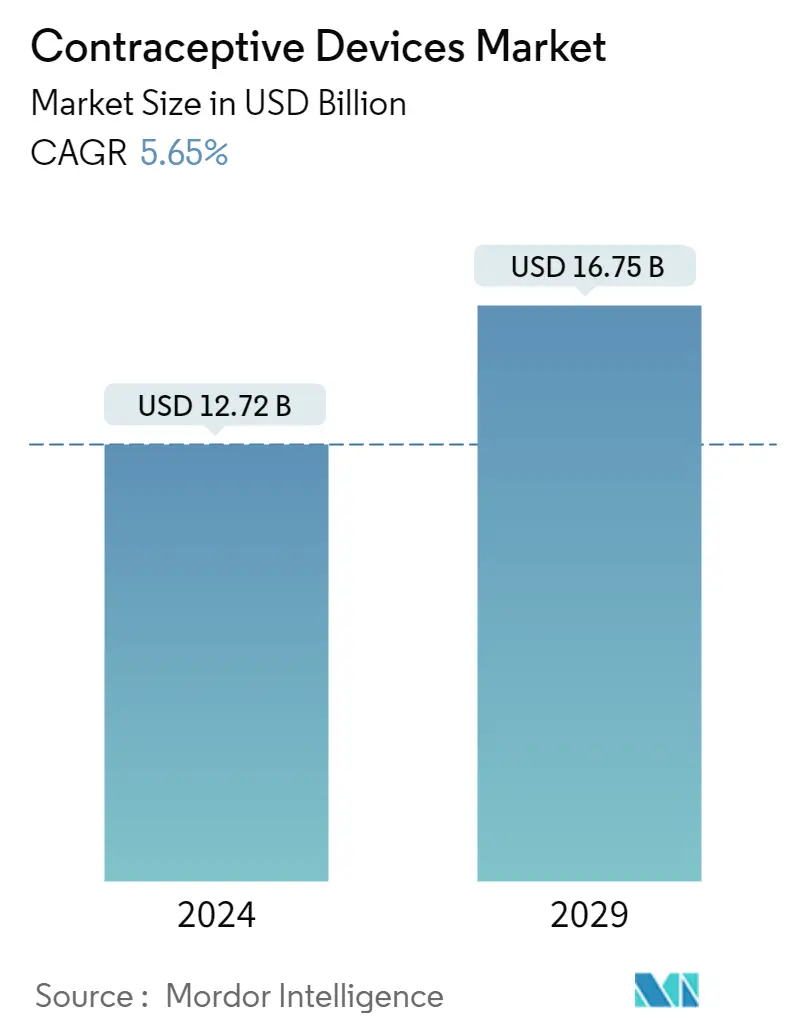Market Size of Contraceptive Devices Industry

| Study Period | 2019 - 2029 |
| Market Size (2024) | USD 12.72 Billion |
| Market Size (2029) | USD 16.75 Billion |
| CAGR (2024 - 2029) | 5.65 % |
| Fastest Growing Market | Asia Pacific |
| Largest Market | North America |
Major Players
*Disclaimer: Major Players sorted in no particular order |
Contraceptive Devices Market Analysis
The Contraceptive Devices Market size is estimated at USD 12.72 billion in 2024, and is expected to reach USD 16.75 billion by 2029, growing at a CAGR of 5.65% during the forecast period (2024-2029).
The COVID-19 pandemic has impacted the growth of the studied market. Initially, the global COVID-19 outbreak and the lockdown scenario in the country have imposed some challenges on the market, as hospitals and clinics were forced to suspend services to prevent the spread of the SARS-CoV-2 virus. The restrictions imposed by the government have significantly impacted the growth of the studied market during the initial period of the pandemic. For instance, according to an article published in March 2022, titled 'Effect of the COVID-19 pandemic on contraceptive prescribing in general practice: a retrospective analysis of English prescribing data between 2019 and 2020', it has been observed that the use of long-acting contraceptives decreased, with implants by 76%, intrauterine systems by 79% and intrauterine devices by 76%. However, with the released COVID-19 restrictions and resumed services, the studied market is expected to grow over the forecast period.
Certain factors that are propelling the market growth are increasing awareness about sexually transmitted diseases, the rising rate of unintended pregnancies, and growing government initiatives.
Unwanted pregnancies are becoming more prevalent globally and are a major cause for concern. For instance, according to the United Nations Population Fund, in March 2022, unintended pregnancies accounted for about half of all pregnancies worldwide, with 121 million occurring each year. As per the same source, over 60% of unplanned pregnancies end in abortion, with an estimated 45% of all abortions being unsafe, resulting in 5%-13% of all maternal fatalities, putting the world's capacity to meet the "Sustainable Development Goals" at risk. Thus, the high rate of unintended pregnancies and unsafe abortions are expected to increase the demand for contraceptive devices, which in turn is anticipated to propel market growth.
In addition, the rising prevalence of sexually transmitted diseases among the population is expected to increase market growth. For instance, according to the report published by the Centers for Disease Control and Prevention in April 2022, it reported that around 133,945 cases of all stages of syphilis were noted,which includes 41,655 cases of primary and secondary syphilis which is considered the most infectious stages of the disease. It also reported an increase of 6.8% in Syphilis during the period 2019 to 2020. The same report also indicated that around 2,148 cases of congenital syphilis were reported in 2020, which includes 149 congenital syphilis-related stillbirths and infant deaths. Additionally, according to the data published by the World Health Organization, in November 2021, it has been observed that around 374 million new infections with one of four sexually transmitted diseases - chlamydia (129 million), gonorrhea (82 million), syphilis (7.1 million) and trichomoniasis (156 million) were recorded in 2020. Thus, the rising burden of sexually transmitted diseases is expected to increase the demand for contraception to avoid getting diseases, thereby propelling market growth.
However, the side effects associated with the use of contraceptive devices are likely to impede the market growth over the forecast period.
Contraceptive Devices Industry Segmentation
As per the scope of the report, contraceptive devices have been barriers that attempt to prevent pregnancy by physically preventing sperm from entering the uterus. Contraception is more commonly known as fertility, and birth control is described as the method used to avoid pregnancy. They include male condoms, female condoms, cervical caps, diaphragms, and contraceptive sponges with spermicide. The Contraceptive Devices Market is segmented by Type (Condoms, Diaphragms, Cervical Caps, Sponges, Vaginal Rings, Intra Uterine Device (IUD), and Other Types), Gender (Male and Female), and Geography (North America, Europe, Asia-Pacific, Middle East and Africa, and South America). The market report also covers the estimated market sizes and trends for 17 different countries across major regions globally. The report offers the value (in USD million) for the above segments.
| By Type | |
| Condoms | |
| Diaphragms | |
| Cervical Caps | |
| Sponges | |
| Vaginal Rings | |
| Intra Uterine Device (IUD) | |
| Other Types |
| By Gender | |
| Male | |
| Female |
| Geography | ||||||||
| ||||||||
| ||||||||
| ||||||||
| ||||||||
|
Contraceptive Devices Market Size Summary
The contraceptive devices market is poised for significant growth over the forecast period, driven by increasing awareness of sexually transmitted diseases and the rising incidence of unintended pregnancies. The market, which experienced initial setbacks due to the COVID-19 pandemic, is expected to recover and expand as healthcare services resume and government initiatives promote contraceptive use. The prevalence of unintended pregnancies, which account for a substantial portion of global pregnancies, coupled with the high rates of unsafe abortions, underscores the critical need for effective contraceptive solutions. Additionally, the rising burden of sexually transmitted diseases is anticipated to further boost demand for contraceptive devices, as individuals seek to prevent infections. Despite potential challenges posed by side effects associated with contraceptive use, the market is expected to witness robust growth, particularly in the female segment, due to increased adoption and awareness.
North America is projected to lead the contraceptive devices market, supported by a well-established healthcare infrastructure, high adoption rates, and proactive government initiatives. The region's growing concern over unwanted pregnancies and sexually transmitted diseases is driving demand for contraceptive solutions, such as male condoms, which offer protection against various pathogens. Strategic initiatives by organizations, including significant funding for the development of new contraceptive technologies, are further propelling market growth. The market is characterized by fragmentation, with key players like AbbVie, Bayer AG, and Cooper Surgical Inc. dominating due to their extensive research capabilities and distribution networks. Emerging players in the Asia-Pacific region are also contributing to market expansion by raising awareness and offering innovative solutions. Overall, the contraceptive devices market is expected to experience substantial growth, driven by a combination of demand factors and strategic industry developments.
Contraceptive Devices Market Size - Table of Contents
-
1. MARKET DYNAMICS
-
1.1 Market Overview
-
1.2 Market Drivers
-
1.2.1 Increasing Awareness about Sexually Transmitted Diseases (STDs)
-
1.2.2 Rising Rate of Unintended Pregnancies
-
1.2.3 Rise in Government Initiatives
-
-
1.3 Market Restraints
-
1.3.1 Side Effects Associated with the Use of Contraceptive Devices
-
-
1.4 Porter's Five Force Analysis
-
1.4.1 Threat of New Entrants
-
1.4.2 Bargaining Power of Buyers/Consumers
-
1.4.3 Bargaining Power of Suppliers
-
1.4.4 Threat of Substitute Products
-
1.4.5 Intensity of Competitive Rivalry
-
-
-
2. MARKET SEGMENTATION (Market Size by Value - USD million)
-
2.1 By Type
-
2.1.1 Condoms
-
2.1.2 Diaphragms
-
2.1.3 Cervical Caps
-
2.1.4 Sponges
-
2.1.5 Vaginal Rings
-
2.1.6 Intra Uterine Device (IUD)
-
2.1.7 Other Types
-
-
2.2 By Gender
-
2.2.1 Male
-
2.2.2 Female
-
-
2.3 Geography
-
2.3.1 North America
-
2.3.1.1 United States
-
2.3.1.2 Canada
-
2.3.1.3 Mexico
-
-
2.3.2 Europe
-
2.3.2.1 Germany
-
2.3.2.2 United Kingdom
-
2.3.2.3 France
-
2.3.2.4 Italy
-
2.3.2.5 Spain
-
2.3.2.6 Rest of Europe
-
-
2.3.3 Asia-Pacific
-
2.3.3.1 China
-
2.3.3.2 Japan
-
2.3.3.3 India
-
2.3.3.4 Australia
-
2.3.3.5 South Korea
-
2.3.3.6 Rest of Asia-Pacific
-
-
2.3.4 Middle East & Africa
-
2.3.4.1 GCC
-
2.3.4.2 South Africa
-
2.3.4.3 Rest of Middle East & Africa
-
-
2.3.5 South America
-
2.3.5.1 Brazil
-
2.3.5.2 Argentina
-
2.3.5.3 Rest of South America
-
-
-
Contraceptive Devices Market Size FAQs
How big is the Contraceptive Devices Market?
The Contraceptive Devices Market size is expected to reach USD 12.72 billion in 2024 and grow at a CAGR of 5.65% to reach USD 16.75 billion by 2029.
What is the current Contraceptive Devices Market size?
In 2024, the Contraceptive Devices Market size is expected to reach USD 12.72 billion.

